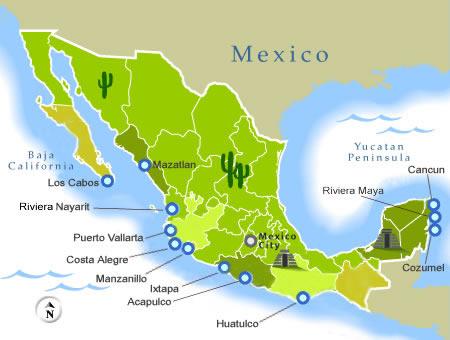
A Short History of Baja California as of 09.27.2009!

Overview of Baja California ~ Time Line:
- 1532: Hernan Cortes sends three ships north along the coast of Mexico in search of the Island of California. The three ships disappear without a trace.
- 1533:
Cortés sends a follow-up mission to search for the
lost ships. Pilot
Fortún Ximénez leads a mutiny and founds a
settlement in the
Bay of La Paz before being killed.

- 1539: Francisco de Ulloa explores both coasts.
- 1690s–1700s: Spanish settlement in California
- 1804: The Spanish colony of California is divided into Alta ("Upper") and Baja ("Lower") California.
- In 1850, after Alta California has been annexed by the United States, Baja California is further divided into northern and southern territories.
- 1853: William Walker, with 45 men, captures the capital city of La Paz and declares himself President of the Republic of Lower California. Mexico forces him to retreat a few months later.
- 1930: Baja California is further divided into Northern and Southern territories.
- 1952: The North Territory of Baja California becomes the 29th state of Mexico, Baja California. The southern portion, below 28°N, remains a federally administered territory.
- 1973: The 1700km (1060 miles) long Trans-Peninsular Highway (Mexican Federal Highway 1), is finished. It is the first paved road that spans the entire peninsula. The highway was built by the Mexican government to improve Baja's economy and increase tourism.
- 1974: The South Territory of Baja California becomes the 31st state, Baja California Sur.
- 1989: Baja California elects Ernesto Ruffo Appel the first non PRI governor since 1929.
Geology:
The Baja California peninsula was once a part of the North American Plate, the tectonic plate of which mainland Mexico remains a part. About 5 million years ago, the East Pacific Rise began cutting into the margin of the North American Plate, initiating the separation of the peninsula from it. Thereafter, the East Pacific Rise continued to propagate northward, up through what is now the Gulf of California. The propagating tip of the spreading center is now located somewhere in the Salton Sea basin. The Baja California peninsula is now part of the Pacific Plate and is moving with it away from the East Pacific Rise in a north northwestward direction. It is an ongoing example of a type of crustal block known as a terrane.
Just up the coast from Santa Rosalia, Baja California Sur is a prominent area of volcanic activity. The arid climate of Baja California allows the dramatic volcanic features of the landscape to stand out clearly for the visitor.